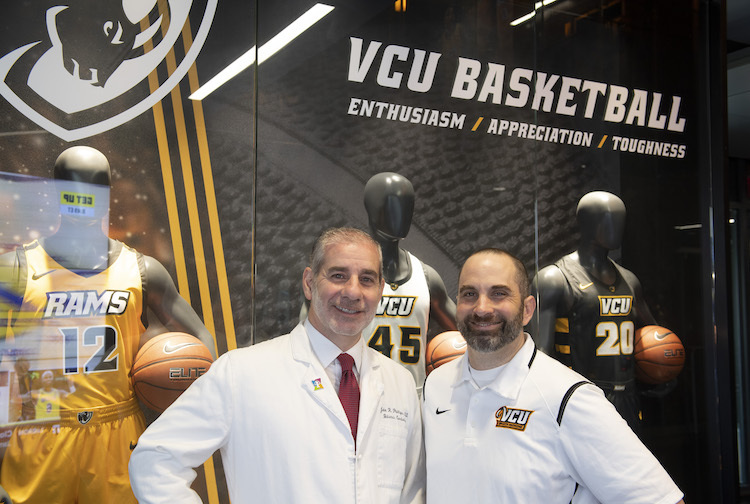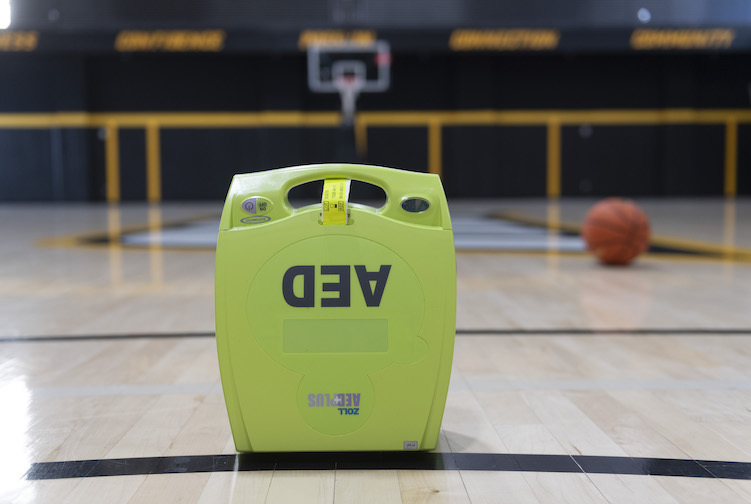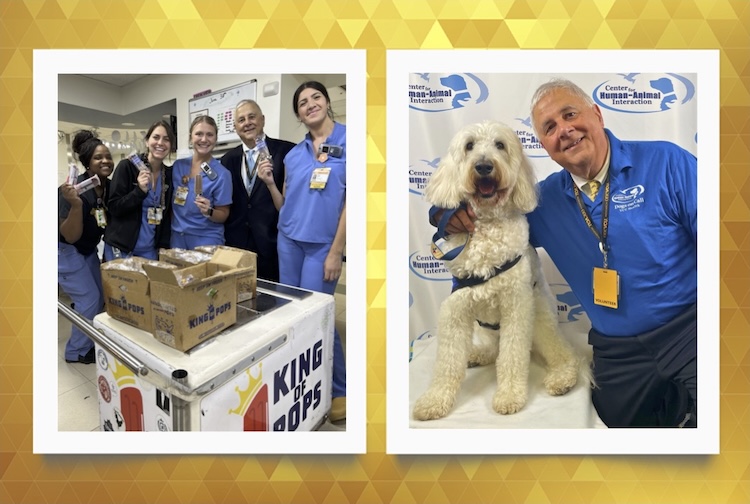What does Damar Hamlin's cardiac arrest tell us about heart health and sports?
VCU and VCU Health experts share approaches to save lives during cardiac emergencies on and off the field.
February 15, 2023 Jeff Collins, VCU's assistant athletic director for sports medicine, stands over a CPR manikin to demonstrate how to do chest compressions in the event of an emergency. (VCU Enterprise Marketing and Communications)
Jeff Collins, VCU's assistant athletic director for sports medicine, stands over a CPR manikin to demonstrate how to do chest compressions in the event of an emergency. (VCU Enterprise Marketing and Communications)
By Joan Tupponce
Football fans were stunned on January 2 to see Buffalo Bills safety Damar Hamlin suddenly fall straight back on the field after making a tackle and suffering cardiac arrest.
Hamlin was eventually released from the hospital and is now back home, but if it had not been for the quick actions of one of the Bills assistant athletic trainers, Denny Kellington, and other medical professionals who administered CPR and used an automated external defibrillator (AED), the outcome may have been very different.
Hamlin suffered what is called commotio cordis, where the chest takes a blow at a specific time in the heart's rhythm.
“If you stimulate the heart at that mili-second of time during ventricular relaxation it causes ventricular fibrillation, that leads to sudden cardiac arrest,” said John Phillips, M.D., director of pediatric electrophysiology at Children's Hospital of Richmond at VCU. “Commotio cordis is not an underlying condition. It's just really bad luck to get struck in the chest at that exact moment of time.”
“Cardiac arrest is the number one cause of sudden death in young athletes.”
- Dr. John Phillips, director of pediatric electrophysiology at Children's Hospital of Richmond at VCU
This uncommon occurrence usually happens in sports, particularly in children who play hockey, baseball and lacrosse.
“It's less likely in football. When you think of the thousands of hits and tackles and that this is the first time it has happened in the NFL that I know of, it's very rare,” Phillips said.
Jeff Collins, VCU assistant athletic director for sports medicine, has been an athletic trainer for 15 years. He's only had to utilize CPR and the AED once during an athletic event.
“But, those things do happen and you have to be prepared,” he said.
Athletic trainers serve as first responders at sporting events, rushing onto the field to assess the severity of the problem. As part of their training, they are CPR and AED certified and re-certified every two years.
“If someone is not breathing and there is no pulse, you begin CPR and utilize the AED. That is what they did on the field,” Collins said.
Immediate care is one of the six domains of athletic training along with injury prevention, clinical evaluation and diagnosis, treatment, rehabilitation and reconditioning, organization and administration as well as professional responsibility.

Dr. John Phillips, director of pediatric electrophysiology at CHoR, and Jeff Collins, VCU assistant director of sports medicine, highlight the important roles medical personnel on
and off the field play in providing care to athletes during emergency events. (VCU Enterprise Marketing and Communications)
Having an emergency plan is crucial to save lives
It's critical when dealing with an incident to have a detailed emergency action plan (EAP) in place. This plan includes locating on-site equipment, specifying the role of each person in an emergency and how to work with medical professionals responding to an incident.
“At VCU, we have an EAP that is venue specific. We rehearse the plans annually for every venue to make sure there are no delays in care and that everyone knows their role in an emergency,” Collins said.
In most cases of sudden cardiac arrest, medical professionals say early and rapid defibrillation with an AED is needed to restore a normal rhythm.
“After four minutes, mortality and morbidity increase exponentially. There is a risk of organ damage and death if you don't defibrillate as soon as possible,” Phillips said. “If a victim is lucky enough to survive, they will be evaluated for underlying diagnoses that lead to arrhythmias and sudden cardiac arrest.”
There are genetic and congenital conditions such as hypertrophic cardiomyopathy, or abnormal thickening of the ventricles in the heart, that can also lead to the arrhythmias that cause cardiac arrest. Additionally, some acquired conditions such as myocarditis, or inflammation of the heart, can lead to sudden cardiac arrest as well as drug use such as cocaine.
Symptoms of these types of conditions can happen while exercising, ranging from chest pain, dizziness or passing out to excessive fatigue and shortness of breath. Phillips says many of his patients with these diagnoses are asymptomatic, with up to 10% experiencing their first symptom as a cardiac arrest.
Most often, people present symptoms between the ages of 15 and 35.
“Cardiac arrest is the number one cause of sudden death in young athletes,” Phillips said.
According to a 2015 study of NCAA athletes titled Incidence, Cause, and Comparative Frequency of Sudden Cardiac Death in National Collegiate Athletic Association Athletes, A Decade in Review, the incidence of sudden cardiac death is one in 54,000 per year and is higher in Black males than any other group.
As part of their training, VCU's athletic trainers are CPR and AED certified and re-certified every two years. (VCU Enterprise Marketing and Communications)
Awareness and training to help during a medical emergency
If an abnormality is found during genetic testing, Phillips says VCU Health team members will test family members, which can also include a physical exam, electrocardiogram, echocardiogram, cardiac MRI or stress test in addition to genetic testing.
“Since most of the congenital and genetic issues have been inherited from family members, you can often identify affected patients through a good family history,” Phillips said.
Parents and athletes should understand that although rare, being prepared for sudden cardiac arrest events through rapid recognition and early CPR and defibrillation are the best ways to prevent death.
“That is what the NFL was — they were prepared on the field with people trained and an AED on the field,” he said.
How exercise strengthens and changes an athlete's heart.
Ensuring that training makes it to the athletic fields of Virginia schools is something CHoR is working on, as the first Virginia affiliate to Project ADAM, which stands for Automated Defibrillation in Adam's Memory. Started in 1999 after the death of Adam Lemel, a 17-year-old Wisconsin high school student who collapsed and died while playing basketball, the national program advocates for access to AEDs and CPR training in schools and communities.
“The out of hospital survival rate is below 10% when you don't have the safety of rapid CPR or a defibrillator in place,” Phillips said.
The affiliation gives CHoR team members the ability to designate any school in Virginia a “Project Adam Heart Safe School,” as long as the institution meets specific criteria to show they're ready and prepared to respond to sudden cardiac arrest on school grounds.
Phillips and Alexis Stevens, Project ADAM program coordinator, work with school coordinators to provide education, training and, if needed, in-person evaluations to help them receive this designation, making cardiac emergencies on and off the field a little less scary in school settings.
While the incident with Hamlin was frightening for fans, Phillips says we can all see the positive outcomes.
“One, he survived. Two, it is bringing light to sudden cardiac arrest and the preparedness you need to ensure survival,” he said.




.jpg)
